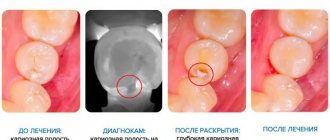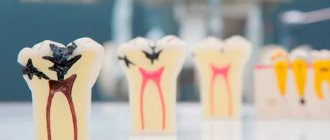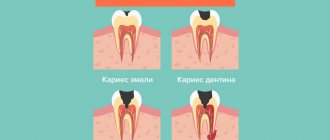Periodontitis in children is an inflammatory process in the tissues surrounding the root of the tooth. This disease is considered one of the complications of caries, although other causes are possible. The periodontium is the area located between the jaw and the roots of the teeth. It develops synchronously with their growth and is constantly changing until the time when permanent teeth are formed.
Treatment of periodontitis in primary teeth in children can be done at CELT dentistry. We offer competitive prices and comfortable conditions for young patients. Our pediatric dentists have extensive experience. Parents can be sure that visits to us will not be a real test for their kids. Treatment of periodontitis in children without pain and tears? This is possible in our clinic!
Consultation with a pediatric dentist (pedodontist) - RUB 1,000.
Apexification with the application of a temporary filling (1 channel) - 1,500 rubles.
Filling the root canals of baby teeth - 4,000 rubles.
Installation of insulating gasket "VITRIBOND" - 800 rubles.
At CELT you can get advice from a dental specialist.
- Cost of consultation with a pediatric dentist (pedodontist) – 1,000
Make an appointment
Causes of periodontitis in children
Dental periodontitis in children can occur due to a number of reasons:
- as a complication of caries that was not treated;
- as a consequence of improper treatment of caries complicated by pulpitis;
- due to chemical damage to the periodontium using canal sterilization agents;
- due to injuries to soft tissues and teeth during falls or accidents.
Complications
A slight aching pain after treatment is a normal reaction of the body. Normally, it lasts no more than a day. If the pain increases, swelling occurs, or the child’s general condition worsens, go to the doctor.
Perhaps the reason is individual intolerance to antiseptic drugs, which caused irritation of the periodontal tissues. In this case, physiotherapy is performed.
If the x-ray shows that the root filling was installed incorrectly, repeated mechanical and medicinal treatment of the canals is performed. This will neutralize and prevent secondary inflammation.
Symptoms of periodontitis
Periodontitis can occur in acute or chronic form. Acute periodontitis in children is characterized by an acute onset and severe, constant, increasing pain. The pain is especially strong when pressing on the diseased tooth and when chewing on it. Other pronounced symptoms:
- swelling of the gums around the tooth;
- fever, weakness and nausea;
- enlarged lymph nodes and their pain.
Chronic periodontitis in children during periods when there are no exacerbations is practically asymptomatic. Pain can only appear when pressure is applied to the tooth or when the tooth comes into contact with something hot or cold. But besides this, other manifestations are possible:
- exacerbations with symptoms characteristic of acute periodontitis of primary teeth in children;
- formation of fistulas on the gums in the granulating form of the disease;
- drowsiness, fatigue, general weakness.
Features of differential diagnosis
Granulating periodontitis must be recognized and distinguished from the following diseases:
- chronic form of moderate caries (at the time of preparation of enamel and dentin, the patient feels pain);
- chronic pulpitis of gangrenous and fibrous types (completely absent radiological changes, sharp pain reaction when probing the pulp horn);
- pulpitis, with a history of complicated focal periodontitis (severe pain and blood when probing the exposed pulp horn; X-ray shows destruction of bone tissue in the bifurcation area and in the apical zone of the roots).
Why is chronic periodontitis dangerous?
The acute form of periodontitis is characterized by pronounced pain, so parents immediately turn to the dentist. The chronic form of the disease occurs latently, and discomfort occurs mainly when eating. If you do not contact specialists in time, the inflammation may spread, and purulent bags will appear on the roots of the teeth. This can ultimately lead to tooth loss. Another unpleasant consequence is that the chronic form can re-exacerbate and lead to sinusitis or periostitis.
CELT pediatric dentists diagnose the chronic form of periodontitis with a preliminary X-ray examination. The selection of treatment is carried out taking into account the prevalence and severity of inflammatory processes, as well as the type of child’s teeth. If treatment is carried out on baby teeth, in order to carry out all the necessary manipulations in full, children are put to sleep using general anesthesia. In each individual case, the issue of pain relief is considered individually. We take into account not only the age of young patients, but also their health status, as well as the wishes of the parents.
Why treating childhood periodontitis at Stokos is the right decision
Our dentistry is where smiles begin. The task of our doctors is to confidently transfer your children into the adult world, which will accept them healthy, strong and full of strength. Among the enviable advantages of our center:
- only modern and safe materials that are used to restore baby and molar teeth;
- experienced pediatric dentists who are not used to working “according to a template” take into account the characteristics of your child’s body, guaranteeing maximum effectiveness of therapy;
- modern technology, high-precision equipment that simplifies the treatment process, ensures comfort and long-lasting results;
- nice atmosphere. Our doctors are on friendly terms with children. With us, your children forget about fear, pain, anxiety - they learn to care for their teeth with pleasure and conscious responsibility;
- loyal prices. We are for making dental care available to children.
Make an appointment with our doctor - don’t waste time, which is priceless!
Treatment of periodontitis in primary teeth
Treatment of periodontitis in primary teeth involves either their removal or the use of conservative techniques. The first is resorted to in extreme cases, since it can lead to such negative consequences as the development of malocclusions and slow development of the jaw. However, the affected tooth is a source of infection, which can affect the buds, and the consequences can be even more serious.
Treatment of periodontitis in children by removing the affected tooth is prescribed in the following cases:
- resorption of the diseased root by more than two-thirds of its length;
- severe mobility of the affected tooth;
- the process of changing to permanent teeth will begin in less than one year;
- conservative treatment does not give the desired result;
- development of sepsis;
- weakening of the child's body.
How periodontitis of primary teeth affects the rudiments of permanent teeth
The health of the molars directly depends on the condition and integrity of the primary teeth. Untimely treatment or ignoring periodontitis has a serious impact on the formation of rudiments and the formation of a permanent dentition. Dentists speak of three phases of molar development and the consequences of periodontitis:
- Formation of the tooth germ - the root is destroyed and dies.
- Crown formation – enamel hypoplasia or complete degradation and absence of a tooth.
- Root formation – a mobile permanent tooth grows, which is easily injured and quickly falls out.
Treatment of periodontitis in permanent teeth
Treatment of periodontitis in permanent teeth in children involves anti-inflammatory therapy. It requires an x-ray, the main purpose of which is to determine how well the child’s dental roots are formed. This is important because treatment of immature roots is much more difficult due to a number of anatomical features. They not only significantly complicate filling, but also increase the risk of medical errors. When applying a filling, calcium hydroxide is used. This material is the best for intra-root therapy for periodontitis. It has a pronounced bactericidal effect and creates a reliable barrier between the affected periodontal tissue and healthy tooth tissues.
Classification
Periodontitis is divided into acute and chronic forms. Acute is divided into purulent and serous.
They are characterized by:
- With the serous variant, an inflammatory process appears. It is manifested by hyperemia and swelling of the tissues, there is no pus.
- The purulent form has a severe course. With it, intensive tissue destruction occurs.
There is also a chronic form, which has a gradual course. Appears as a complication after an acute form that is not properly treated.
Conservative treatment of periodontitis
CELT dentists widely use conservative methods for treating the symptoms of periodontitis in a child. If there is even the slightest opportunity to save a tooth without removing it, they do everything that depends on them. Endodontic treatment is carried out in a complex and involves the use of physiotherapy, which is an additional means to eliminate inflammatory processes. The procedures may be as follows:
- electrophoresis of antiseptic pharmacological drugs;
- laser therapy aimed at sterilizing tooth canals;
- phonophoresis of antiseptic agents using ultrasound.
The main treatment requires two visits, the first of which:
- the carious cavity is cleaned and softened dentin is removed from it;
- in order to expand the mouth of the canals, a hand instrument is used, after which the necrotic nerve is removed;
- expand and thoroughly clean the canal, rinse it with an antiseptic;
- the apical foramen is opened, which allows for exudation;
- the canal is filled with calcium hydroxide-based paste (if the tooth is permanent) or oil-based paste (if the tooth is milky).
After 5 - 10 days, during which the small patient is prescribed rinsing the mouth with antiseptics, along with taking antibiotics, a second visit is required. It provides for the following activities:
- Cleaning the dental canal and removing medicinal paste;
- Using an antiseptic solution for rinsing;
- Canal filling with gutta-percha, tooth filling.
Features of the treatment of periodontitis in patients
Treatment of periodontitis must be comprehensive. Periodontitis can be completely treated in two to three visits to the clinic. Sometimes, in very advanced cases, five visits to the clinic for treatment will be required to exclude the development of pathology and save the affected tooth.
Stages of periodontitis treatment during the first visit with acute pain:
Initial examination at the dentist.
The specialist examines the condition of the tooth and performs x-rays. Based on the results of the x-ray, the shape and type of periodontitis is determined, and a plan for further treatment is drawn up;
- Anesthesia.
Anesthesia in the treatment of periodontitis is desirable, since deep tissue opening is expected, which will be accompanied by pain and discomfort;
- Removal of caries.
The dentist removes caries, drills out damaged dentin, gradually moving towards the dental canals;
- Working with fabrics.
The specialist removes the destroyed pulp if required by the treatment protocol. In some cases, the pulp can be preserved, for example, if periodontitis did not develop against the background of pulpitis, but as a result of poor-quality filling in the past. Then the dentist opens the filling, cleans the canals and preserves the pulp;
- Working with channels.
The dentist, using a special tool, expands the canals and treats them with antiseptic compounds in order to remove foci of inflammation;
- Installation of a temporary filling.
The crown is closed with a temporary filling. During this time, the patient can undergo physiotherapeutic treatment.
At this stage, the patient is sent home until the next visit.
Note! When a granuloma grows to too large a size, surgical treatment, unfortunately, cannot be avoided. Then the doctor prescribes resection of the root apex.
Stages of treatment of periodontitis after three to four days from the date of initial treatment:
- Removing the temporary filling.
If the patient has no complaints of pain and discomfort, there is no swelling of the gums, the filling material is opened, the canals are cleaned of antiseptic;
- Flushing the canals.
The washing procedure is performed using special antibacterial solutions with a high content of calcium hydroxide.
- Temporary filling.
The filling remains for a period of two to three months.
During the treatment process, physiotherapeutic techniques demonstrate good results. For example, intracanal electrophoresis, laser therapy, ultrasound therapy.
The next stage is the final stage of treatment, and it includes the following steps:
- Taking an x-ray. At this stage of treatment, it is important to make sure that the pathological process is stopped, the tooth is no longer destroyed, and periodontal inflammation has stopped.
- Removing a temporary filling. The temporary filling is removed and the canals are washed again with an antiseptic solution.
- Canal filling. If the x-ray confirms the success of healing, a permanent filling is placed and the crown is restored. Also, the peri-root tissues are necessarily treated with special antimicrobial compounds, which will help prevent recurrence of inflammation.
It is important! With a competent approach to treatment, it will not be visually noticeable that any manipulations were performed with the pathological tooth. It will be perfectly restored, matching the natural one in shape, color, and enamel transparency. By contacting the doctor in time, you will maintain a healthy and strong tooth.
Surgical treatment of periodontitis
Surgical treatment of chronic periodontitis in children may be required during periods of exacerbation or if the use of conservative methods does not produce the desired result. It is also used in cases of granuloma formation or canal obstruction. To do this, an operation is performed to resection the root apex. This is a complex surgical intervention that involves making an incision along the gum, peeling off the mucous membrane, and creating a small hole to gain access to the affected area. The dentist removes the root tip along with the granuloma, fills the free space with synthetic bone tissue and medicine, and sutures the wound. The technique is used only on permanent teeth; milk teeth are removed without preliminary manipulation.
Features of the course of chronic granulomatous periodontitis
This pathology develops only after the formation of roots and periodontium is complete. Growth to the sides and deeper into the granulation tissue is limited from the unaffected bone by a connective tissue capsule. Its fibers are extensively woven into the periodontium. Since the surrounding bone is dense, the lesion is clearly defined on x-ray.
The disease is also asymptomatic, with the exception of rare pain when pressing, and is accompanied by a change in tooth color. Probing and percussion do not cause pain, there is no reaction to temperature stimuli. The tooth may be intact or may have a carious cavity or filling.
X-ray signs
- Destruction of the cortical plate of the alveolus in the area of the apex of the roots of the damaged tooth.
- The clearing segment of the bone tissue has a round or oval shape and perfect outline, and its diameter does not exceed 4-5 mm.
Differential diagnosis
It is necessary to distinguish granulomatous periodontitis from the following diseases:
- deep chronic caries (treatment of caries in children is accompanied by pain during preparation of the enamel-dentin junction, reaction to cold);
- chronic gangrenous and fibrous pulpitis, complicated by focal periodontitis (sharp pain on probing);
- fibrous and granulating chronic periodontitis (diagnosed using x-ray);
- cystogranuloma and radicular cyst (in this case, the focus of destruction will be more than 5-8 mm).
Treatment methods
Treatment of periodontitis in primary teeth is carried out conservatively, surgically or by removing the affected unit. In all cases, the doctor’s goal is to completely eliminate the inflammatory process and regenerate jaw tissue.
Removal of a tooth
Tooth extraction is carried out only in cases where conservative treatment is impossible, ineffective or inappropriate. The procedure is carried out under local anesthesia, and in case of pronounced psycho-emotional agitation of the child - under sedation. In the latter case, the baby sleeps during the procedure and does not see what is happening. Removal is indicated in the following cases:
- the tooth is excessively mobile;
- The replacement of teeth has begun, and a new one will soon grow in place of the removed one;
- the disease recurred after conservative treatment;
- bone destruction has begun near the permanent tooth germ;
- the child’s immunity is significantly reduced, there is a threat of sepsis;
- the root of the baby tooth has resolved by more than 2/3.
The procedure itself is carried out using generally accepted techniques. Forceps are applied to the crown, after which the affected unit is dislocated from the socket and removed outward. The hole is inspected for tooth remains, and then clamped with a swab. The total manipulation time rarely exceeds 20–30 minutes.
Surgery
Surgical treatment is performed if conservative methods are ineffective, and the doctor’s goal is to preserve the tooth. One of the indications for surgery is the formation of an abscess in the area of the root apex. The intervention is carried out under local anesthesia and sedation to avoid psychological trauma to the child. During the work, the doctor makes an incision in the gum, removes the tip of the affected root, washes the wound from pus, places an antibacterial agent in it, and then applies sutures. The procedure takes about 40 minutes, and complete healing will take 10–14 days.
Conservative therapy
Conservative treatment of periodontitis in children is carried out in 3 visits, the interval between which is 3–7 days, depending on the clinical situation.
I visit. Under local anesthesia, the carious cavity is opened, destroyed tissue is removed and root canals are treated. The tooth is left open, soda baths are prescribed 6-7 times a day.
II visit. The cavity is treated with an antiseptic solution, after which a turunda soaked in an anti-inflammatory compound is inserted into it and a temporary filling is installed.
III visit. The temporary filling and turunda are removed, and the canals are obturated with absorbable paste. After this, an insulating lining and a permanent filling are installed in the tooth.
To increase the effectiveness of conservative therapy and speed up recovery, physiotherapy methods (electrophoresis, phonophoresis, laser) are used. This allows you to improve blood supply to the affected area and stimulate regenerative processes.
In Moscow, dental specialists treat childhood periodontitis. We use the most effective anesthetics and sedatives, so the process will be completely painless and safe for your baby. The clinic’s doctors know how to find an approach even to those children who begin to worry at the first mention of the dentist. Thanks to this, the kids leave the office with a smile, and later agree to a new visit to the doctor without any problems. “Stomos” uses the most effective methods of conservative therapy, so surgery can be avoided in the vast majority of cases.










